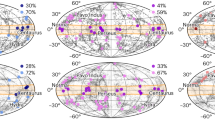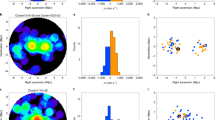Abstract
One of the most powerful tools used in attempts to understand the structure of the Universe is the correlation function ξ(r), the excess probability over random that there are two objects separated by a distance r. In particular, distributions of galaxies and of clusters of galaxies have been investigated using this parameter. Here we show that if the amplitudes of the cluster–cluster correlation function is made dimensionless, systematic changes with cluster richness vanish, implying scale invariance in the clustering process. The dimensionless galaxy–galaxy correlation seems stronger, implying gravitational enhancement on smaller scales.
This is a preview of subscription content, access via your institution
Access options
Subscribe to this journal
Receive 51 print issues and online access
$199.00 per year
only $3.90 per issue
Buy this article
- Purchase on Springer Link
- Instant access to full article PDF
Prices may be subject to local taxes which are calculated during checkout
Similar content being viewed by others
References
Groth, E. J. & Peebles, P. J. E. Astrophys. J. 217, 385–405 (1977).
Bahcall, N. A. & Soneira, R. A. Astrophys. J. 270, 20–38 (1983).
Klypin, A. A. & Kopylov, A. I. Sov. Astr. Lett. 9, 41–46 (1983).
Hauser, M. G. & Peebles, P. J. E. Astrophys. J. 185, 757–786 (1973).
Schectman, S. A. Astrophys. J. (in the press).
Kaiser, N. Astrophys. J. 284, L9–L12 (1984).
Mandelbrot, B. B. Fractals (Freeman, San Francisco, 1977).
Adler, R. J. The Geometry of Random Fields (Wiley, New York, 1981).
White, S. D. M. Proc. Inner Space/Outer Space (University of Chicago Press, 1985).
Schulman, L. S. & Seiden, P. E. IBM Rep. RC-10369 (1984).
Carr, B. J., Bond, J. R. & Arnett, D. Astrophys. J. 277, 445–469 (1984).
Carr, B. J. & Ikeuchi, S. Kyoto Preprint RIFP-550 (1984).
Turok, N. & Albrecht, A. ITP Santa Barbara Preprint (1984).
Turock, N. & Schramm, D. N. Nature 312, 598–599 (1984).
Davis, M. & Huchra, J. Astrophys. J. 254, 437–454 (1982).
Author information
Authors and Affiliations
Rights and permissions
About this article
Cite this article
Szalay, A., Schramm, D. Are galaxies more strongly correlated than clusters?. Nature 314, 718–719 (1985). https://doi.org/10.1038/314718a0
Received:
Accepted:
Issue Date:
DOI: https://doi.org/10.1038/314718a0
This article is cited by
-
The large-scale smoothness of the Universe
Nature (1999)
Comments
By submitting a comment you agree to abide by our Terms and Community Guidelines. If you find something abusive or that does not comply with our terms or guidelines please flag it as inappropriate.



